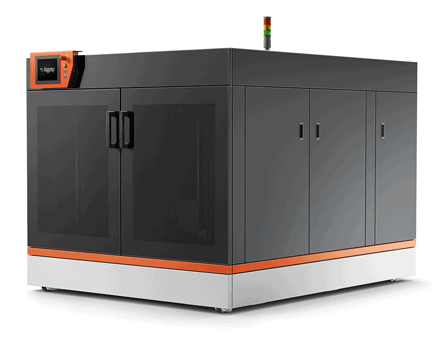Large-scale 3D printing is transforming industries, making it possible to create everything from massive architectural structures to full-sized automotive components with unprecedented efficiency. As the technology advances, businesses and innovators are finding new ways to push the limits of what can be achieved with a large scale 3D printer.
This guide will walk you through the essential aspects of large-format 3D printing, including the technologies involved, materials used, technical challenges, and future trends. Whether you’re an industry professional or an enthusiast looking to scale up your 3D printing capabilities, understanding these fundamentals is key to mastering this cutting-edge technology.
Understanding Large-Scale 3D Printing
Unlike standard desktop 3D printers, which typically print objects within a few cubic inches, large-scale 3D printing refers to printers capable of producing objects that measure several feet in height, width, and depth. These machines enable the production of prototypes, industrial parts, and even entire buildings with remarkable precision.
Key Industries Benefiting from Large-Scale 3D Printing
Massive 3D-printed structures, including houses, bridges, and office buildings, are revolutionizing the construction industry. These structures are built using concrete extrusion technology, which allows for rapid, cost-effective production with minimal waste.
Both industries are leveraging large-scale 3D printing to produce lightweight, strong, and complex components. By reducing the number of parts in an assembly, manufacturers can improve fuel efficiency and streamline production.
From prosthetics to customized implants, large-scale 3D printing is reshaping healthcare. Bioprinting, a revolutionary application, is being explored for printing tissues and even organs.
Artists and designers are using large-scale printers to create sculptures, furniture, and intricate installations that would be difficult or impossible to produce with traditional techniques.
Essential Technologies for Large-Scale 3D Printing
Advancements in 3D printing technology have made it possible to manufacture large-scale objects with precision, speed, and efficiency, utilizing various methods tailored to specific industry needs.
Types of Large-Scale 3D Printing Technologies
FDM is one of the most widely used methods for large-scale 3D printing. It works by extruding thermoplastic material layer by layer to form large objects. It’s cost-effective and widely accessible but may have limitations in print resolution and strength.
These resin-based techniques offer high precision and smooth finishes, making them ideal for applications requiring fine details. However, they are more commonly used for medium-scale printing rather than massive objects.
These methods use lasers to fuse powdered materials, making them ideal for strong, industrial-grade parts. Metal 3D printing is particularly useful in aerospace and automotive applications.
This technology is being increasingly used in construction to print entire buildings, reducing labor costs and material waste while allowing for complex and sustainable architectural designs.
Choosing the Right Printer for Large-Scale Projects
Selecting the right large scale 3D printer depends on factors such as build volume, material compatibility, resolution, and budget. Some of the leading options on the market today include the BigRep series, the WASP construction printer, and the Thermwood LSAM for large industrial applications.
Materials for Large-Scale 3D Printing
Selecting the right materials is crucial for achieving the desired strength, durability, and functionality in large-scale 3D printing. Different applications require specific material properties, from lightweight polymers to industrial-grade metals and concrete.
Types of Materials Used
Materials such as PLA, ABS, and PETG are widely used for large-scale FDM printing due to their affordability and versatility. Carbon-fiber-reinforced polymers provide added strength for industrial applications.
Metal 3D printing allows for the production of strong, heat-resistant components used in aerospace, automotive, and medical applications. Titanium, aluminum, and stainless steel are commonly used materials.
Ideal for the construction industry, concrete printing allows for sustainable, large-scale building production. Ceramic materials are also used for artistic and industrial applications.
With growing concerns over sustainability, researchers are developing biodegradable and recycled materials to reduce the environmental impact of 3D printing.
Material Challenges & Solutions
Large-scale printing materials can present issues like warping, shrinkage, and adhesion problems. To mitigate these, proper temperature control, optimized print settings, and advanced support structures are essential.
Overcoming Technical Challenges in Large-Scale 3D Printing
Larger prints are more prone to layer adhesion issues, warping, and internal stress. Strategies such as controlled cooling, heated chambers, and reinforced infill structures can improve print quality and durability.
High-speed printing can compromise accuracy. Using advanced slicing software to fine-tune speed settings, optimizing layer height, and employing multi-axis printing techniques can help achieve the perfect balance between speed and precision.
For large objects, designing effective support structures is crucial to prevent print failures. Advanced techniques like dissolvable supports and optimized bridging strategies reduce material waste and post-processing efforts.
Software & Workflow Optimization
CAD software such as SolidWorks and Fusion 360 is essential for designing large prints. Slicing software like Cura, Simplify3D, and PrusaSlicer offers features specifically tailored for large-format printing.
AI-driven tools are enhancing large-scale printing by predicting failures, optimizing print parameters, and enabling real-time monitoring. Automation is also streamlining workflows in industrial settings.
Cost Considerations & ROI in Large-Scale 3D Printing
While a large scale printer requires a significant upfront investment, the long-term benefits include reduced material costs, lower labor expenses, and faster production times.
Efficient material usage, recycling programs, and sustainable printing practices help businesses minimize waste and enhance cost efficiency.
Conclusion
Large-scale 3D printing is revolutionizing industries, enabling faster, more efficient, and cost-effective manufacturing processes. By understanding the technologies, materials, and challenges involved, professionals can harness the full potential of a large scale 3D printer.
With advancements in automation, AI, and sustainable materials, the future of large-format 3D printing is brighter than ever. Whether you’re looking to innovate in construction, aerospace, healthcare, or design, mastering this technology will open new doors for creativity and efficiency.



